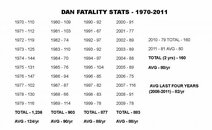Ken Kurtis
Contributor
I promised in the Catalina fatality stats thread to compile the national numbers and have finally gotten around to that. Shout-thanks to Jeannette Moore at DAN (along with Petar Denoble) for providing some missing info.
Here are the numbers. I'm inserting this as JPG so I can create a chart with columns. Hopefully it displays here. Remember that these represent fatality counts for US & Canadian compressed gas divers (so no freedivers, but would include rebreathers, hookahs, etc.), diving in the US or abroad, and any foreign divers who died while diving in the US. I've grouped things by decade to hopefully factor out some of the statistical anomolies & swings. The DAN folks also caution not to jump to any knee-jerk conclusions about the sudden uptick in the 2007 numbers (although they do seem to stick out like a sore thumb):

One problem here, to state it again, is that we have numerators but no denominators. On the surface (no pun intended), the average fatality rate/year for each decade is going down. But there's no way to really evaluate the significance of that without knowing not only how many divers there are but - more importantly - how many total dives are being made.
If the total number of dives made each year is the same, then the rate is indeed going down. But if we are hypothetically doing half as many total annual dives 2008-2011 as we were doing 1970-1979, the avaerge number/year would have decreased by 34% but the deaths/dive would actually have increased by 32%.
The point is, be careful what conclusions you draw from the numbers.
- Ken
Here are the numbers. I'm inserting this as JPG so I can create a chart with columns. Hopefully it displays here. Remember that these represent fatality counts for US & Canadian compressed gas divers (so no freedivers, but would include rebreathers, hookahs, etc.), diving in the US or abroad, and any foreign divers who died while diving in the US. I've grouped things by decade to hopefully factor out some of the statistical anomolies & swings. The DAN folks also caution not to jump to any knee-jerk conclusions about the sudden uptick in the 2007 numbers (although they do seem to stick out like a sore thumb):

One problem here, to state it again, is that we have numerators but no denominators. On the surface (no pun intended), the average fatality rate/year for each decade is going down. But there's no way to really evaluate the significance of that without knowing not only how many divers there are but - more importantly - how many total dives are being made.
If the total number of dives made each year is the same, then the rate is indeed going down. But if we are hypothetically doing half as many total annual dives 2008-2011 as we were doing 1970-1979, the avaerge number/year would have decreased by 34% but the deaths/dive would actually have increased by 32%.
The point is, be careful what conclusions you draw from the numbers.
- Ken
Last edited:




